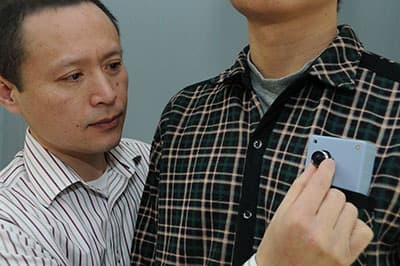Wearable Device For Visually Impaired To Avoid Bumping Into Things
It is a sad fact that even after so much advance in our technology, there are very few devices to ease the already difficult life of specially-abled people. It seems however that a change is coming. A group of researchers from Massachusetts Eye and Ear, Schepens Eye Research Institute have come together a formed a device that will help the visually disabled people avoid collisions. The findings of these researchers were published in Investigative Ophthalmology and Visual Science (IOVS).

There are certain devices out in the market for the same purpose but those devices predict collision on the basis of distance from obstacles while this device predicts collision based on time to collision. The difference between the two might seem subtle however it is anything but that. The problem with distance-based prediction is that it gives warnings even when user is just standing near an object or when a moving object is just passing by. Technically speaking, distance-based device can give a large number of ‘false positives’. These problems are overcome by this yet-to-be-named time-based prediction device.
In order to evaluate the benefit of the device, the researchers developed an obstacle course and tested this device on 25 people. For testing, they needed a baseline which was travelling the obstacle course without the device. These 25 people who were all suffering from either tunnel vision or hemianopia (blindness over half the field of vision) completed the obstacle course and their number of collisions and walking speed were compared. It was found that the collisions were reduced by 37% with an insignificant change in the walking speed. This proved that the device doesn’t affect the speed of walking and reduces collision considerably.
Please have a look at the video below to see the demonstration of the device.
Source: #-Link-Snipped-#

There are certain devices out in the market for the same purpose but those devices predict collision on the basis of distance from obstacles while this device predicts collision based on time to collision. The difference between the two might seem subtle however it is anything but that. The problem with distance-based prediction is that it gives warnings even when user is just standing near an object or when a moving object is just passing by. Technically speaking, distance-based device can give a large number of ‘false positives’. These problems are overcome by this yet-to-be-named time-based prediction device.
In order to evaluate the benefit of the device, the researchers developed an obstacle course and tested this device on 25 people. For testing, they needed a baseline which was travelling the obstacle course without the device. These 25 people who were all suffering from either tunnel vision or hemianopia (blindness over half the field of vision) completed the obstacle course and their number of collisions and walking speed were compared. It was found that the collisions were reduced by 37% with an insignificant change in the walking speed. This proved that the device doesn’t affect the speed of walking and reduces collision considerably.
Please have a look at the video below to see the demonstration of the device.
0
